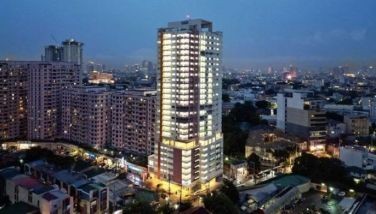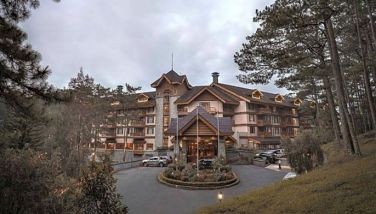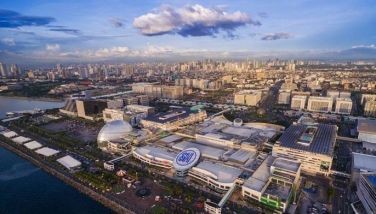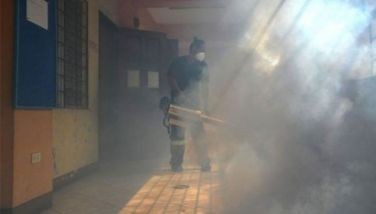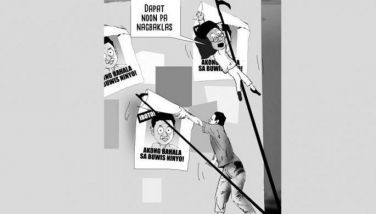Mayon erupts anew; 25,000 evacuated
July 27, 2001 | 12:00am
LEGAZPI CITY — Mayon Volcano erupted at about 7:56 a.m. yesterday, threatening at least 18 villages and forcing as many as 25,000 people to flee.
The Philippine Institute of Volcanology and Seismology (Phivolcs) raised the highest Alert Level 5 and started evacuating re-sidents within the danger zone of six to seven kilometers around the volcano.
Rumbling could be heard as far as 10 kilometers away as the volcano ejected a 200-foot fountain of lava and ash clouds mushroomed 10 kilometers into the air.
"We were surprised by its sudden explosion. We were told to evacuate last night but we did not know it would explode so fast," said Legazpi City Mayor Noel Rosal.
Authorities said they received no immediate reports of damage or injuries but hadn’t inspected all areas affected by the eruption. Classes in nearby schools were suspended and all flights to and from Legazpi City were suspended.
Phivolcs volcanologist Julio Sabit said scientists first learned of an imminent eruption from sudden lava flows and started an evacuation less than four hours before the 7:56 explosion.
Another blast rattled the area six and a half hours later but, volcanologists said, the intensity had already waned.
"There was an earthquake and we heard roaring thunder, and after, we heard the frying sound of eggs when the pebbles were falling on our roofs," said Joe Malasarte of Malabog town at the volcano’s foot.
The school children of Malabog screamed and fled after the explosion while panicked villagers streamed down the mountainsides, many crowding roads with private vehicles.
Military trucks rolled into affected areas and ferried villagers into evacuation centers while the Air Force placed two helicopters on standby to augment rescue operations.
Army Col. Dante Bonifacio, Task Force Mayon commander, said 12 M-35 trucks had been ferrying hundreds of evacuees at the designated pick-up points since the order to evacuate was given early yesterday morning. Albay Gov. Al Francis Bichara said about 25,000 people have been evacuated with the number "still growing."
He said about 30 buildings, mostly schoolhouses, were converted into cramped evacuation centers which could hold up to 60,000 people but Bichara said funds and supplies are quickly dwindling.
"We cannot afford to sustain these people," Bichara said as he appealed to the national government for help.
The greatest danger from the volcano are the ground-hugging clouds of superheated gas, ash and rock fragments, called pyroclastic flows, that speed down from the summit.
Such pyroclastic flows can reach speeds of up to 100 kilometers per hour and temperatures of 700 degrees Celsius, incinerating anything in their path.
Volcanologists reported that pyroclastic flows reached 5.5 kilometers from the summit, incinerating coconut plantations on Mayon’s slope.
The gray sulfuric ash it spewed blackened the early morning sky and turned day into night as far as the towns of Sto. Domingo, Guinobatan, Camalig, Daraga and Malilipot and Legazpi City.
"The ashfall is continuing but we still don’t have a total assessment report," said provincial disaster chief Cedric Daep. "There were parts that were too dark. In some villages there was zero visibility."
Disaster officials advised residents to wear dust masks and sweep off ash from rooftops because quickly accumulating ash could cause houses to collapse.
The Department of Health regional office reported that it had already released some 20,000 dust masks to the Provincial Disaster Coordinating Center (PDCC).
Health Secretary Manuel Dayrit assured the people that hospitals in the Bicol region are well-equipped to handle medical emergencies but said he had not received any report of death or injury yesterday.
Dayrit, however, warned residents against ashfall which, he said, could cause eye irritation and infection as well as nasal stuffiness, throat irritation, coughing and chest tightness.
Volcanologists said yesterday’s blast appeared more violent than its last eruption on June 24 when more than 50,000 residents were evacuated.
Camalig town Mayor Paz Muñoz said it was the first time since 1968 that pebbles and sand fell into the poblacion.
"It must really be a stronger explosion than the previous ones. In fact, this is the first time since the 1968 eruption that pebbles reached our town poblacion," Paz said.
Philvolcs volcanologist said they could not predict how long this latest bout of eruptions would last but stressed that they are expecting more explosive eruptions in the next few days.
The cone-shaped volcano acted up June 23 when it emitted smoke, ash and lava for two weeks but ceased erupting on July 4, leading authorities to allow some of the evacuees to return home.
Mayon’s most destructive eruption was in 1814 when 1,200 people were killed and the entire town of Cagsawa was buried in volcanic mud. — With Felix de los Santos, Mayen Jaymalin
The Philippine Institute of Volcanology and Seismology (Phivolcs) raised the highest Alert Level 5 and started evacuating re-sidents within the danger zone of six to seven kilometers around the volcano.
Rumbling could be heard as far as 10 kilometers away as the volcano ejected a 200-foot fountain of lava and ash clouds mushroomed 10 kilometers into the air.
"We were surprised by its sudden explosion. We were told to evacuate last night but we did not know it would explode so fast," said Legazpi City Mayor Noel Rosal.
Authorities said they received no immediate reports of damage or injuries but hadn’t inspected all areas affected by the eruption. Classes in nearby schools were suspended and all flights to and from Legazpi City were suspended.
Phivolcs volcanologist Julio Sabit said scientists first learned of an imminent eruption from sudden lava flows and started an evacuation less than four hours before the 7:56 explosion.
Another blast rattled the area six and a half hours later but, volcanologists said, the intensity had already waned.
"There was an earthquake and we heard roaring thunder, and after, we heard the frying sound of eggs when the pebbles were falling on our roofs," said Joe Malasarte of Malabog town at the volcano’s foot.
The school children of Malabog screamed and fled after the explosion while panicked villagers streamed down the mountainsides, many crowding roads with private vehicles.
Military trucks rolled into affected areas and ferried villagers into evacuation centers while the Air Force placed two helicopters on standby to augment rescue operations.
Army Col. Dante Bonifacio, Task Force Mayon commander, said 12 M-35 trucks had been ferrying hundreds of evacuees at the designated pick-up points since the order to evacuate was given early yesterday morning. Albay Gov. Al Francis Bichara said about 25,000 people have been evacuated with the number "still growing."
He said about 30 buildings, mostly schoolhouses, were converted into cramped evacuation centers which could hold up to 60,000 people but Bichara said funds and supplies are quickly dwindling.
"We cannot afford to sustain these people," Bichara said as he appealed to the national government for help.
The greatest danger from the volcano are the ground-hugging clouds of superheated gas, ash and rock fragments, called pyroclastic flows, that speed down from the summit.
Such pyroclastic flows can reach speeds of up to 100 kilometers per hour and temperatures of 700 degrees Celsius, incinerating anything in their path.
Volcanologists reported that pyroclastic flows reached 5.5 kilometers from the summit, incinerating coconut plantations on Mayon’s slope.
The gray sulfuric ash it spewed blackened the early morning sky and turned day into night as far as the towns of Sto. Domingo, Guinobatan, Camalig, Daraga and Malilipot and Legazpi City.
"The ashfall is continuing but we still don’t have a total assessment report," said provincial disaster chief Cedric Daep. "There were parts that were too dark. In some villages there was zero visibility."
Disaster officials advised residents to wear dust masks and sweep off ash from rooftops because quickly accumulating ash could cause houses to collapse.
The Department of Health regional office reported that it had already released some 20,000 dust masks to the Provincial Disaster Coordinating Center (PDCC).
Health Secretary Manuel Dayrit assured the people that hospitals in the Bicol region are well-equipped to handle medical emergencies but said he had not received any report of death or injury yesterday.
Dayrit, however, warned residents against ashfall which, he said, could cause eye irritation and infection as well as nasal stuffiness, throat irritation, coughing and chest tightness.
Volcanologists said yesterday’s blast appeared more violent than its last eruption on June 24 when more than 50,000 residents were evacuated.
Camalig town Mayor Paz Muñoz said it was the first time since 1968 that pebbles and sand fell into the poblacion.
"It must really be a stronger explosion than the previous ones. In fact, this is the first time since the 1968 eruption that pebbles reached our town poblacion," Paz said.
Philvolcs volcanologist said they could not predict how long this latest bout of eruptions would last but stressed that they are expecting more explosive eruptions in the next few days.
The cone-shaped volcano acted up June 23 when it emitted smoke, ash and lava for two weeks but ceased erupting on July 4, leading authorities to allow some of the evacuees to return home.
Mayon’s most destructive eruption was in 1814 when 1,200 people were killed and the entire town of Cagsawa was buried in volcanic mud. — With Felix de los Santos, Mayen Jaymalin
BrandSpace Articles
<
>
- Latest
- Trending
Trending
Latest
Trending
Latest
Recommended






